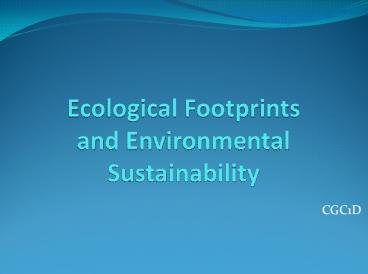Ecological Footprints and Environmental Sustainability - PowerPoint PPT Presentation
Title:
Ecological Footprints and Environmental Sustainability
Description:
What is an ecological footprint? Ecological Footprints are a measure of human impact on the Earth. The footprint equals the Earth s cost to sustain one person. – PowerPoint PPT presentation
Number of Views:243
Avg rating:3.0/5.0
Title: Ecological Footprints and Environmental Sustainability
1
Ecological Footprints and Environmental
Sustainability
- CGC1D
2
What is an ecological footprint?
3
Ecological Footprints are
- a measure of human impact on the Earth. The
footprint equals the Earths cost to sustain one
person. Its measured in hectares and represents
the land area needed to provide resources and
absorb waste and greenhouse gases produced by an
individual.
4
What are the numbers?
- World Average 2.2 hectares
- Biggest Footprint United States 9.6 hectares
- Smallest Footprint Bangladesh 0.5 hectares
- Average Canadian Footprint 8.6 hectares
- Canada has the 3rd highest footprint in the
world! - Why is Canadas average footprint so big?
5
What do we need?
- We require ..
- 0.2 hectares of land for water (to drink
provide seafood) - hectares of land for home and roads and factories
that make the material things we grave - 1.6 hectares of land for farmland to grow the
food we eat - 0.3 hectares of land for grazing land for meat
and dairy - 1.4 hectares of land for timber wood and paper
products - 4.7 hectares of land and needed to absorb the
greenhouse gases produced by driving around town,
through the running of air conditioners and the
import of exotic goods and foods - 8.6 hectares
6
Ecological Impact of Nations
- The map on the following slide shows various
countries and regions of the world proportionate
to their production and consumption of
commercially traded fuels. - All figures are in million metric tons of oil
equivalent.
7
Ecological Impact of Nations
8
Ecological Impact of Nations
9
How Much Land do we Have?
10
Defining Environment Sustainability
- Stewardship refers to the responsibility we all
have to the environment and resources that has
been left to us by our ancestors. We are all
stewards to our planet. - Sustainability refers to the ability to develop
in order to meet the needs of the present without
negatively affecting the ability of future
generations to meet their needs
11
Defining Environment Sustainability
- If we are not all following our role as stewards
in the global village, then we will not have a
sustainable environment for our future children. - We do not inherit the earth from our
grandparents, we borrow it from our children. - We must all do our part to keep our consumption
of resources to a minimum, and to keep the
environment around us clean. - Are you doing your part?
12
How a Greenhouse Works
The rays become weaker once they bounce off
something, so they are not all able to pierce
back through the glass the temperature inside
rises.
The suns rays are strong enough to pierce
through the glass of the greenhouse.
13
The Greenhouse Effect - Now
Some rays are strong enough to escape back into
space
Atmosphere
Some rays are held in by the atmosphere
Suns rays
14
The Greenhouse Effect - Now
A thickened atmosphere, caused by pollution
More rays are held in, warming up the Earth
Suns rays
15
Defining Environment Sustainability
- Climate Change is a major shift in the overall
temperature levels of the Earth (up or down). - Global Warming is the rising of the average
temperature of Earth. - The Greenhouse Effect is the trapping of heat by
the Earths thickened atmosphere. This is caused
by pollution.
16
Who Will Speak for the Trees?































